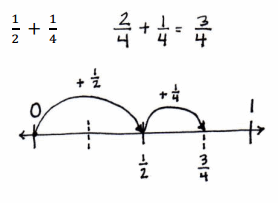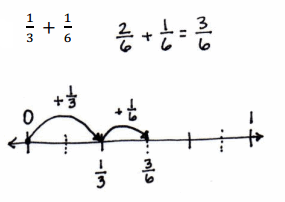Engage NY Eureka Math 4th Grade Module 5 Lesson 20 Answer Key
Question 1.
Use a tape diagram to represent each addend. Decompose one of the tape diagrams to make like units. Then, write the complete number sentence. Part (a) is partially completed.
a. \(\frac{1}{4}\) + \(\frac{1}{8}\)

Answer:
2/8 + 1/8 = 3/8.
Explanation:
In the above-given question,
given that,
\(\frac{1}{4}\) + \(\frac{1}{8}\).
1/4 + 1/8.
1/4 = 2/8.
2/8 + 1/8 = 3/8.
b. \(\frac{1}{4}\) + \(\frac{1}{12}\)
Answer:
4/12 + 1/12 = 5/12.
Explanation:
In the above-given question,
given that,
\(\frac{1}{4}\) + \(\frac{1}{12}\).
1/4 + 1/12.
1/4 = 4/12.
4/12 + 1/12 = 5/12.
c. \(\frac{2}{6}\) + \(\frac{1}{3}\)
Answer:
2/6 + 1/3 = 4/6.
Explanation:
In the above-given question,
given that,
\(\frac{1}{4}\) + \(\frac{1}{8}\).
1/3 + 2/6.
1/3 = 2/6.
2/6 + 2/6 = 4/6.
d. \(\frac{1}{2}\) + \(\frac{3}{8}\)
Answer:
1/2 + 3/8 = 6/8.
Explanation:
In the above-given question,
given that,
\(\frac{1}{4}\) + \(\frac{1}{8}\).
1/2 + 3/8.
1/2 = 3/8.
3/8 + 3/8 = 6/8.
e. \(\frac{3}{10}\) + \(\frac{3}{5}\)
Answer:
3/10 + 3/5 = 9/10.
Explanation:
In the above-given question,
given that,
\(\frac{1}{4}\) + \(\frac{1}{8}\).
3/10 + 3/5.
3/5 = 3/10.
3/10 + 3/5 = 9/10.
f. \(\frac{2}{3}\) + \(\frac{2}{9}\)
Answer:
2/3 + 2/9 = 4/9.
Explanation:
In the above-given question,
given that,
\(\frac{2}{3}\) + \(\frac{2}{9}\).
2/9 + 2/3.
2/3 = 2/9.
2/3 + 2/9 = 4/9.
Question 2.
Estimate to determine if the sum is between 0 and 1 or 1 and 2. Draw a number line to model the addition. Then, write a complete number sentence. Part (a) has been completed for you.
a. 
Answer:
1/2 + 1/4 = 3/4.
Explanation:
In the above-given question,
given that,
1/2 + 1/4.
2/4 = 1/2.
2/4 + 1/4 = 3/4.
1/2 + 1/4 = 3/4.
b. \(\frac{1}{2}\) + \(\frac{4}{10}\)
Answer:
1/2 + 4/10 = 9/10.
Explanation:
In the above-given question,
given that,
1/2 + 4/10.
5/10 = 1/2.
5/10 + 4/10 = 9/10.
1/2 + 4/10 = 9/10.
c. \(\frac{6}{10}\) + \(\frac{1}{2}\)
Answer:
6/10 + 1/2 = 11/10.
Explanation:
In the above-given question,
given that,
1/2 + 6/10.
5/10 = 1/2.
5/10 + 6/10 = 11/10.
1/2 + 6/10 = 11/10.
d. \(\frac{2}{3}\) + \(\frac{3}{6}\)
Answer:
2/3 + 3/6 = 5/6.
Explanation:
In the above-given question,
given that,
2/3 + 3/6.
2/3 + 3/6 = 5/6.
e. \(\frac{3}{4}\) + \(\frac{6}{8}\)
Answer:
3/4 + 6/8 = 6/4.
Explanation:
In the above-given question,
given that,
3/4 + 6/8.
6/8 = 3/4.
3/4 + 3/4 = 6/4.
3/4 + 6/8 = 6/4.
f. \(\frac{4}{10}\) + \(\frac{6}{5}\)
Answer:
4/10 + 6/5 = 8/5.
Explanation:
In the above-given question,
given that,
4/10 + 6/5.
4/10 = 2/5.
6/5 + 2/5 = 8/5.
6/5 + 4/10 = 8/5.
Question 3.
Solve the following addition problem without drawing a model. Show your work.
\(\frac{2}{3}\) + \(\frac{4}{6}\)
Answer:
2/3 + 4/6 = 4/3.
Explanation:
In the above-given question,
given that,
2/3 + 4/6.
4/6 = 2/3.
2/3 + 2/3 = 4/3.
2/3 + 4/6 = 4/3.
Eureka Math Grade 4 Module 5 Lesson 20 Exit Ticket Answer Key
Question 1.
Draw a number line to model the addition. Solve, and then write a complete number sentence.
\(\frac{5}{8}\) + \(\frac{2}{4}\)
Answer:
5/8 + 2/4 = 7/8.
Explanation:
In the above-given question,
given that,
5/8 + 2/4.
4, 8 = 8.
5/8 + 2/4 = 7/8.
Question 2.
Solve without drawing a model.
\(\frac{3}{4}\) + \(\frac{1}{2}\)
Answer:
3/4 + 1/2 = 4/4.
Explanation:
In the above-given question,
given that,
3/4 + 1/2.
l.c.m of 4, 2 = 4.
3/4 + 1/2 = 4/4.
3/4 + 1/2 = 1.
Eureka Math Grade 4 Module 5 Lesson 20 Homework Answer Key
Question 1.
Use a tape diagram to represent each addend. Decompose one of the tape diagrams to make like units. Then, write the complete number sentence.
a. \(\frac{1}{3}\) + \(\frac{1}{6}\)
Answer:
1/3 + 1/6 = 2/6.
Explanation:
In the above-given question,
given that,
1/3 + 1/6.
l.c.m of 3,6 = 6.
1/3 + 1/6 = 2/6.
b. \(\frac{1}{2}\) + \(\frac{1}{4}\)
Answer:
1/2 + 1/4 = 2/4.
Explanation:
In the above-given question,
given that,
1/2 + 1/4.
l.c.m of 2, 4 = 4.
1/2 + 1/4 = 2/4.
c. \(\frac{3}{4}\) + \(\frac{1}{8}\)
Answer:
3/4 + 1/8 = 4/8.
Explanation:
In the above-given question,
given that,
3/4 + 1/8.
L.C.M of 4,8 = 4.
3/4 + 1/8 = 4/8.
d. \(\frac{1}{4}\) + \(\frac{5}{12}\)
Answer:
1/4 + 5/12 = 6/12.
Explanation:
In the above-given question,
given that,
1/4 + 5/12.
l.c.m of 4,12 = 12.
1/4 + 5/12 = 6/12.
e. \(\frac{3}{8}\) + \(\frac{1}{2}\)
Answer:
3/8 + 1/2 = 7/8.
Explanation:
In the above-given question,
given that,
3/8 + 1/2.
4/8 = 1/2.
3/8 + 4/8 = 7/8.
3/8 + 1/2 = 7/8.
f. \(\frac{3}{5}\) + \(\frac{3}{10}\)
Answer:
3/5 + 3/10 = 6/10.
Explanation:
In the above-given question,
given that,
3/5 + 3/10.
3/5 + 3/10 = 6/10.
Question 2.
Estimate to determine if the sum is between 0 and 1 or 1 and 2. Draw a number line to model the addition. Then, write a complete number sentence. The first one has been completed for you.
a. 
Answer:
1/3 + 1/6 = 2/6.
Explanation:
In the above-given question,
given that,
\(\frac{1}{3}\) + \(\frac{1}{6}\).
1/3 + 1/6.
l.c.m of 3,6 = 6.
1/3 + 1/6 = 2/6.
b. \(\frac{3}{5}\) + \(\frac{7}{10}\)
Answer:
3/5 + 7/10 = 10/10.
Explanation:
In the above-given question,
given that,
\(\frac{3}{5}\) + \(\frac{7}{10}\).
3/5 + 7/10.
L.c.m of 5,10 = 10.
3/5 + 7/10 = 10/10.
c. \(\frac{5}{12}\) + \(\frac{1}{4}\)
Answer:
5/12 + 1/4 = 2/4.
Explanation:
In the above-given question,
given that,
\(\frac{5}{12}\) + \(\frac{1}{4}\).
5/12 + 1/4.
5/12 = 1/4.
5/12 + 1/4 = 2/4.
d. \(\frac{3}{4}\) + \(\frac{5}{8}\)
Answer:
3/4 + 5/8 = 8/8.
Explanation:
In the above-given question,
given that,
\(\frac{3}{4}\) + \(\frac{5}{8}\).
3/4 + 5/8.
l.c.m of 4,8 = 8.
3/4 + 5/8 = 8/8.
e. \(\frac{7}{8}\) + \(\frac{3}{4}\)
Answer:
7/8 + 3/4 = 10/8.
Explanation:
In the above-given question,
given that,
\(\frac{7}{8}\) + \(\frac{3}{4}\).
7/8 + 3/4.
l.c.m of 8,4 = 8.
7/8 + 3/4 = 10/8.
f. \(\frac{1}{6}\) + \(\frac{5}{3}\)
Answer:
1/6 + 5/3 = 6/6.
Explanation:
In the above-given question,
given that,
\(\frac{1}{4}\) + \(\frac{1}{8}\).
1/6 + 5/3.
l.c.m of 6,3 = 6.
1/6 + 5/3 = 6/6.
Question 3.
Solve the following addition problem without drawing a model. Show your work.
\(\frac{5}{6}\) + \(\frac{1}{3}\)
Answer:
5/6 + 1/3 = 6/6.
Explanation:
In the above-given question,
given that,
\(\frac{5}{6}\) + \(\frac{1}{3}\).
5/6 + 1/3.
l.c.m of 6,3 = 6.
5/6 + 1/3 = 6/6.